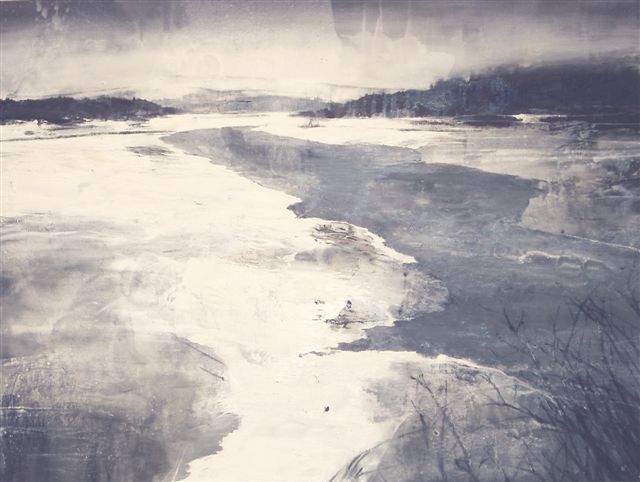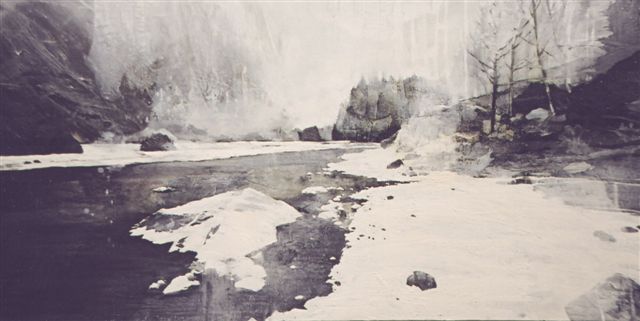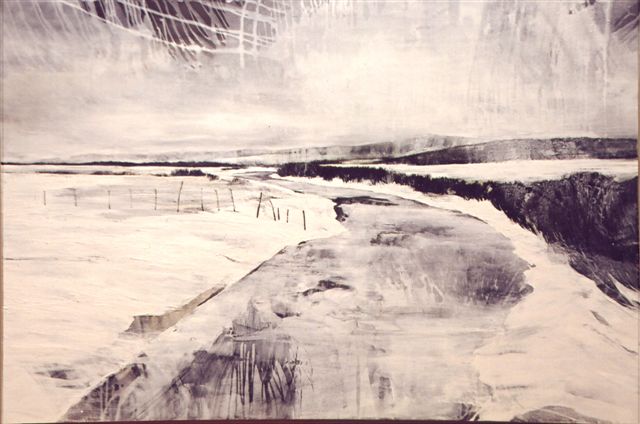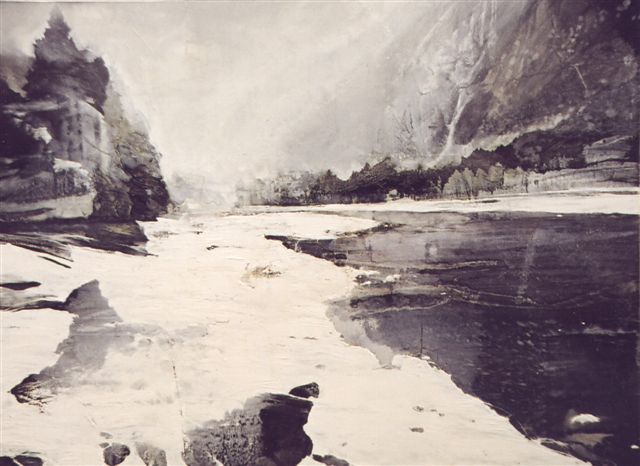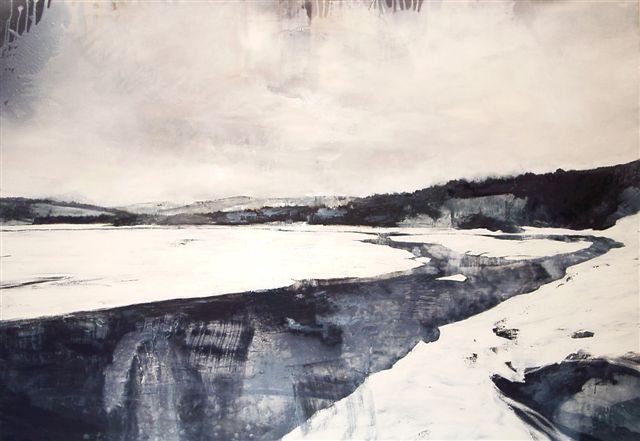
INTRODUCTION
History remembers the great explorers in their descriptions of what they
discovered. Foreign cultures saw their own history through the eyes of
the explorers. Mark Thompson explores the drama of Nordic landscapes –
a love for the mountains of Iceland and Norway, for the snow, the water
and the threatening storms on the horizon.
He reveals to us what we have always observed yet never been aware of.
Seeing Nordic landscapes through the eyes of an English painter is part
of a long history of landscape painting. Mark Thompson creates romantic
images of them.
The dramatic theme is not as is, but as could have been.
As seen by the explorers, and retold in paintings by numerous artists
through history.
The painter J. C. Dahl, who was born in Bergen in 1788 but spent most
of his artistic life in Germany (d.1857), has become the icon of the Norwegian
romantic tradition. He came home at regular intervals with his sketchbook,
but produced his painting upon returning to Germany, with a view from
abroad. His romantic but exaggerated images contributed strongly to the
independence movement.
With this backdrop we begin a journey of exhibition. First to the soft
meadows of Lithuania, more similar to the English countryside than to
Icelandic volcanoes or Norwegian waterfalls.
Later to Bergen and Western Norway.
Our purpose is to facilitate meetings between Norwegian and foreign artists,
institutions and the public. We have rarely ever been able to combine
these two objectives better than with this exhibition of Mark Thompson.
The M. K. Ciurlionis National Museum of Art is becoming increasingly international.
Since Lithuania’s regained independence this museum has developed
a large international network through exchange of exhibitions. Foundation
3,14 is proud to contribute to fulfilling this purpose.
March 2002
Foundation 3,14
Bergen
Norway
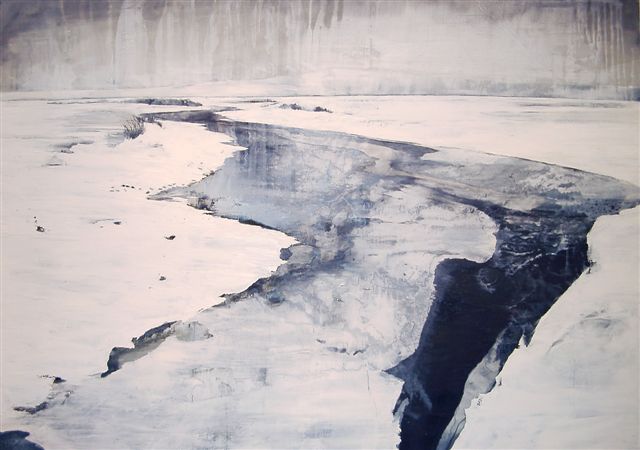
MARK THOMPSON, LANDSCAPES OF THE HEART
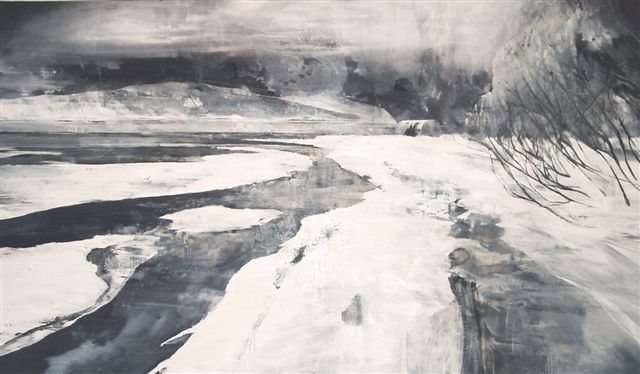
LANDSCAPE
OF THE HEART
By Martin Gayford
For many people there is, so to speak, a landscape of the heart. Generations
of Northern Europeans have found their ideal on the shores of the Mediterranean
in a Claudean paradise of golden light and rippling water. But there have
also always been those who found their spiritual homeland in the north,
among fjords, seals, black rock, ice and snow.
William Morris, the 19th century craftsman, designer and political theorist
was one such; he never made the customary artistic pilgrimage to Italy,
but instead made the great journey of his life to Iceland. Another contemporary
example is the painter Mark Thompson.
Born in the dead flat plain of the Fens in Eastern England – he began
as an abstract painter. But eventually, he found that his true preoccupation
as a painter was landscape. (There has always been a close connection
between landscape painting and abstraction, of course – Mondrian
and Kandinsky found their landscapes turning into abstracts, Thompson’s
evolved in the opposite direction).
In recent years he has spent a number of months each year travelling –
in northern places such as Norway, Finland, Iceland and Alaska. His purpose,
he explains is ‘to go out into the landscape - being a sponge, soaking
it up.’ The terrain he seeks out is characterised by its remoteness,
and emptiness. Not only is it deserted, there is little sign that the
hand of man has ever made a mark on it. On returning to his studio, he
starts to paint. But his object is not depict a particular place, rather
– as he puts it – it is ‘to find a place’. While travelling
he makes photographs, drawings and above all written notes of what he
sees. But the process of painting begins in a way that suggests an abstract
expressionist such as Jackson Pollock rather than a topographical artist.
There is, he says, ‘a lot of throwing the paint around, and a lot
of pouring’.
Through that physical moving of the pigment, he tries to find the place
he is looking for. ‘There’s always a picture inside your head,
an internal landscape that you are trying to find an equivalent to in
the external world.’ So the result is in part a reconstruction of
what he has seen, in part a discovery of the ideal he was searching for.
That method of work – reconstructing landscapes from memory back
in the studio – is reminiscent of the German Romantic painter Caspar
David Friedrich, a master of the past whom Thompson greatly admires. Friedrich
was also born in a flat landscape – the Baltic coast, rather than
the Fenland – and went on to paint more mountainous regions, in his
case the peaks of Eastern Germany. Friedrich also made studies on the
spot, but painted his final work in a bare studio with a view only of
the sky, closing – it was said – his bodily eye so that he could
bring into the light of darkness what he had seen in darkness.
Thompson’s painting is related to the drips and spatter of gestural
abstraction, but also to the sublime tradition of landscape painting to
which Friedrich and Turner belonged. In that tradition the viewer is confronted
by the immensity and emptiness of the world – not by a real place,
nor an unreal one either. What Thompson does, he says, is all ‘to
do with the filter of memory’. What remains in the memory. Perhaps
that is the essence of what has been seen, but also what was being sought
out, the landscape of the heart.
